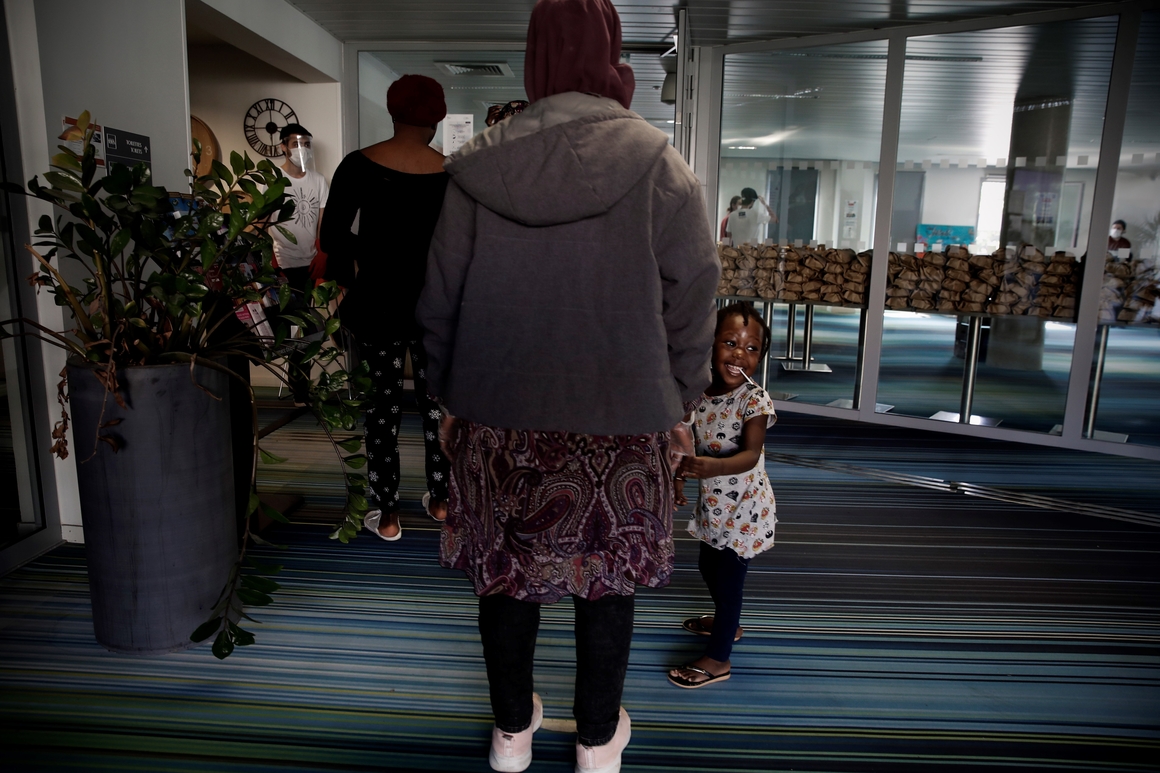
With social distancing here to stay for the foreseeable future, it’s becoming increasingly clear that the next stage of the pandemic is going to change many lives for the worse.
Specifically, it’s going to exasperate existing inequalities, as the privileged buffer themselves against its pernicious effects while the world’s most vulnerable struggle not to fall through the rapidly widening economic fissures.
Take schools. Even as some countries reopen classrooms — some with limited attendance, or alternated timetables — there’s still uncertainty about how and when a generation of young people, from nursery age to postgraduate, will be able to get their education permanently back on track.
“There are hopes that schools and universities could be open in the autumn, but there is no guarantee that they would get through another academic year without needing to move online again at some point, if there’s a second wave of the virus,” said Carl Cullinane of the U.K.’s Sutton Trust think tank, which has a particular focus on inequalities in education — something he says are being “highlighted and exacerbated” by coronavirus .
At every stage of the educational journey, the virus has hit, storing up potential problems — particularly for those already at a disadvantage (children from better-off families who might have their own personal laptop are able to enjoy the benefits of online learning much more easily than children from a family with only one laptop in the household, or none).
“We try to be positive, emphasizing the range of policies and mitigation strategies that can be taken,” Cullinane said. “But it will likely be difficult to avoid long-term harm being done to this current generation, particularly if the effects are on-and-off for the next year to 18 months.”
For educational institutions that rely on funding from parents or students — in the U.K., for instance, nurseries have found themselves in particular financial trouble — the long-term future of the business is now at risk, Cullinane said.
Never mind the dilemma of how you get a 4-year-old to wear a face mask or to social distance at nursery — there might not be a nursery for them to go to, something that would put many working parents in a bind.
Pupils stepping up from primary education to secondary are also at particular risk, said Cullinane. That’s “one of the big periods where [inequalities] open up.” This year, it’s possible we could see pupils entering secondary school in September, “not having been in a school room since early March,” he added.
“It is potentially extremely damaging for, particularly, disadvantaged pupils who may not have had the support over those few months at home that other pupils might have had,” he said. “The scars of the current crisis are going to still be showing in the long term.”
Then there’s jobs. The economic hardships of lockdown, furthermore, are hitting those low-pay sectors worse than high-pay.
While well-paid employees in the financial sector can telework from home, factory-workers, waiters and receptionists can’t. Lower-paid jobs are „hit hardest now and they may not come back as fully as white-collar jobs do,” said Ian Mulheirn, a former U.K. government economist and now an executive director at former prime minister Tony Blair’s Institute for Global Change think tank.
“The tradeable nature of some of the high-skill services the U.K. specializes in won’t really be affected by this massively in the long-run, but lots of these other jobs will be,” he added.
The pain is expected to be particularly keen in the service sector, as bars, cafes, restaurants, nightclubs and hotels are potentially forced to stay under lockdown long after restrictions on other sectors have eased.
In Britain, the industry association UK Hospitality is drawing up protocols for different varieties of venue under different levels of social distancing restriction. Whatever happens, said chief executive Kate Nicholls, there is more economic pain coming down the track.
Evidence from Sweden indicates that even where there is no enforced lockdown in place, people’s behaviour has still changed. “Restaurants and hotels that some of our businesses operate [in Sweden] are reporting that there is a sort of self-imposed social distancing going on by their consumers,” she said. “The town and city center restaurants are by no means full, they’re operating at sub-50 percent.”
Meanwhile, the experience of post-lockdown China and other Asian countries, where restrictions have been imposed then lifted, is also worrying. „With hotels, occupancy and revenues were 20 to 30 percent [what they would typically be],” Nicholls said. “Restaurants, when they reopened with social distancing in place, saw immediately reduced capacity and revenue 30 to 50 percent of what you would normally expect.”
With the chances of a rapid bounce back looking remote, Nicholls believes governments will need to shift from economy-wide bailout measures to targeted support for sectors, like hers, that could take the worst hit.
“It will all have been for nothing if the support that was in place for the hard lockdown … was suddenly cut off,” she said. “That would just mean we’d postponed the pain of the job losses and the business failures rather than helping to allow those businesses to survive and play their part in the economic recovery.”
The economic disruption caused by the pandemic and the lockdowns means the coronavirus is more than an immediate threat to public health; it will likely cause suffering far into the future.
The financial crash of the last decade — and the austerity that followed — contributed to a stalling in life expectancy improvements in the U.K., according to Michael Marmot, a professor of epidemiology at University College London, who tracked the negative effects.
Marmot fears a similar scar could be left by coronavirus — only bigger: “In 2009, the year after Lehman Brothers collapsed, the global economy shrank by 0.1 percent,” he said.
“Now they’re projecting a 3 percent drop,” he added, citing the International Monetary Fund’s forecast for global growth earlier this month. “It’s huge. And the poorer you are the more likely you are either to have to work outside the home — you can’t socially isolate — or to lose your job.”
All the determinants of long-term health Marmot has spent decades studying — early child development, education, employment and working conditions, having enough money to live on, healthy places and communities — will all be impacted, he believes. “In the short term there will be increases in inequalities in social conditions, which will over time lead to inequalities in health.”
Compounding the problem will be the stored-up afflictions of millions of Europeans with underlying conditions — cancer, heart disease, diabetes and others — who have not received the diagnoses, treatments or surgery that they might have done because health systems have been consumed with the coronavirus response.
In the U.K. alone, around 200,000 people every week are no longer being screened for bowel, breast and cervical cancer, according to the Cancer Research UK charity. “There will be a significant number of early cancers left undetected before these programmes can be reintroduced,” they said.
Zooming out, international inequalities are another significant worry, and not just for poorer countries, said Catherine Rhodes, executive director of the Cambridge University’s Centre for the Study of Existential Risk.
Speaking at the beginning of April, Rhodes — whose academic discipline requires her to envision the worst-case scenarios — said the impact of coronavirus on developing countries was her biggest concern.
“Even the things that seem simple here, like social distancing, that’s not going to be possible if you’re living in a slum, or a refugee camp, or any intensely crowded setting,” she said.
“What understandably gets overlooked sometimes by governments is that, of course they need to look to what their national citizens are wanting and needing,” she added. “But in an outbreak like this, if we … just try and limit what gets into our own country, it will just keep circulating.”
The development of a vaccine will, Rhodes predicts, present deep dilemmas for policymakers. If and when we get one, the immediate question will be: how and where to distribute it? “From the point of view of a national government … its population is not going to be happy if it sees they could have had this vaccine and [the government] let it go to other countries,” Rhodes said.
But getting vaccines to vulnerable populations around the world is precisely, she added, “what a global response will most benefit from.”
Supporting an international vaccination effort could prove politically difficult for countries struggling to find the funds to support a recovery effort — or simply trying to stop the economic bleeding.
On the macroeconomic side, the immediate painful question is how long can the current, unprecedented state intervention in markets around Europe be maintained? With the state so heavily involved in the economy, at what point (and how) do governments start deciding which companies survive, and why?
If the hospitality sector, for instance, has to stay in deep freeze for months and months to come, or if ongoing border restrictions mean airlines can’t fly, how long can the taxpayer prop up businesses in these and other worst-hit sectors?
“For policymakers, I think the challenge is that there is an economic case for supporting those sectors to return to something like a sustainable normal,” said Mulheirn from the Institute for Global Change. “But policymakers obviously have no idea where that new normal will settle.”
Addressing growing inequality and defusing the health time bomb will require governments to resist cost-cutting austerity measures, said Marmot, the professor of epidemiology.
He noted that after the financial crisis, governments argued they had no choice but to cut health and other basic services. “And what happened when the COVID-19 pandemic hit?” he said. “They threw all of that orthodoxy out of the window and said, ‘Whatever it takes.'“
“If you can do it in a pandemic you can do it for the profound problem of inequalities and resultant health inequalities in society,” he added.
Governments will face defining choices about how to square the spending circle in the months and years ahead, said Mulheirn.
Not only will demands on social support systems be greater — with millions more unemployed — there could also be increased pressure for well-funded public services, as people’s admiration for health workers’ efforts to combat the pandemic converts into political support for them to be fairly paid and resourced.
“How are these expectations going to be met,” he asked, in a likely context of widespread business failure, falling business revenues and therefore a significantly shrunken tax base?
How all this shapes politics in the months and years to come is perhaps the biggest and most consequential unknown. Traumatized economies and unequal societies in the past decade proved fertile ground for unforeseen political movements: Trump, Brexit, rising European populism.
Polling by Ifop, in France, already suggests that those who are finding lockdown the most challenging are the poorest. If there is an ever-widening divide between those who were pummeled by the pandemic, and those who (thanks to their economic security, or the nature of their work) were able to weather the blows, that will at some point find a political outlet. The only question is how strong will that reaction turns out to be.
This article is part of POLITICO’s premium policy service: Pro Health Care. From drug pricing, EMA, vaccines, pharma and more, our specialized journalists keep you on top of the topics driving the health care policy agenda. Email [email protected] for a complimentary trial.
Source: politico.com
See more here: news365.stream





